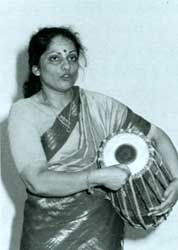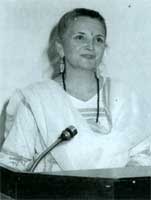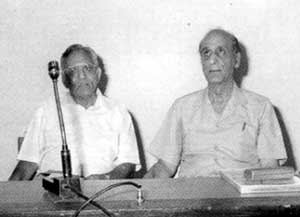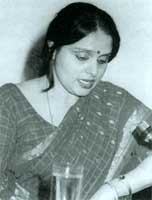



EVENTS
Mridangam, Then and Now
India has a rich variety of musical instruments. The various musical instruments have been evolved over a period of time. They are mainly classified into String instruments (tala vadya or tanthri vadya), Wind instruments (sushira vadya) and Percussion instruments (Avanaddha vadya)
Mridangam is a percussion instrument, which provides rhythm in a classical music concert. It is considered to be the most melodious and auspicious percussion instrument among all the Avanaddha Vadyas (Membranophones).
Then intricate science of rhythm is displayed when a Mridangam player accompanies music and dance performances. With rhythm, music is brought within a definite structure and it gets a precise form of presentation. Ms. Shreejayanthi Gopal, a Mridangam player presented a lecture-demonstration (March 3) on `Mridangam Avanaddha Vadya from Ancient Times to Present Day.’
Discussing the origin of Mridangam, she said, a small drum called “Dhakka” or “Damaru” in the hands of Nataraja, the cosmic dancer, is the one, which maintains rhythm in the whole of eternity. Further, it is interesting to know that the sound emanated from this cosmic drum is the source for the science of language.
This aspect finds mention in a verse in our ancient text Nandikeshwara Karika, which says that at the end of the cosmic dance, Nataraja (Shiva) twirled his “damaru” (cosmic drum) in such a way that it beat nine and five times and the science of language was born. This primeval vibration comprised all tones of music as well.
Damaru is the first percussion instrument made out of leather (charma Vadya). Mridangam was more popular as an accompanying percussion instrument to music and dance because of its musical tone. The sound emanated by mridangam was considered to be highly auspicious and an augury of good omen.
In Bharata’s Natyashastra (2nd B.C. to 2nd A.D.) there is a detailed discussion on Avanaddha Vadya (chapter Avanaddhavidhihi), which narrates the complete characteristics of Mridangam, Panava and Dardara. Here, mridangam is referred to as pushkara vadya and classified as ankya mridangam, alingya mridangam and urdhva mridangam. These classifications are based, according to the position in which the mridangam is held for playing.
The term “Mridangam” is derived from the Sanskrit word mrit+angam, meaning body of clay. The present day mridangam appears to be a gradual evolution of the pushkara vadya and became more popular. Over the years, the highly evolved method of its design and construction has enabled the instrument to give out harmonic overtones, that is suitable for chamber music and this tonal quality has elevated the instrument to the status of a sophisticated concert drum.
Vedic Astrology
Dr. Mireille-Josephine Guezennec teaches Vedic philosophy at Sorbonne University in France. She has spent many years in India for her researches and reportages. She holds a Ph.D. in Indian Philosophy and a degree in Sanskrit. She is also an Astrologer.
In a lecture (April 11) in IGNCA on Philosophy of Vedic Astrology-Jyotisha As The Supreme Link Between Macrocosm and Microcosm, she explored the cosmological and philosophical foundations of Vedic Astrology and the principles of Jyotisha as a paradigm, which allows sential relationship between Man (microcosm) and of Universe (macrocosm). She explained how the interpretation of a chart (Horoscope) could give man a better understanding and help in the attainment of his unique mission in life.
Dr. Mireille-Josephine (Himabindu) is a keen photographer and has learnt Bharatnatyam from Guru Mutu-swami Pillai and studied the dance treaties likeNatyasastra and Abhinaya Darpana from Guru Gangadhar Praddhan.
Painting Under Sikh Rule
Maharaja Ranjit Singh was a great warrior, the first Indian ruler who conquered the Pathan (Pasthun) and Hazara areas on the Afghan borders after fiercely contested battles. He also was the first Indian ruler to have crossed the Khyber Pass and establish a fort at Jamrud in Afghan territory in the last one thousand years. Hence the rule of Maharaja Ranjit Singh marks an important date in the history of the region.
In a lecture (May 7), Dr. C.K. Atal, traced the `Development of the Art of Painting Under Sikh Rule (1799-1860 AD). A positive development during Rankit Singh’s rule was that the artistes who had lost the patronage of smaller kings, who had been defeated sought support among Ranjit Singh’s ministers, governors and courtiers. Thus an active interaction developed among the hill painters, many of whom also migrated to Lahore and Amritsar to work for their rich patrons providing a fillip to development and refinement of the existing art. The miniature-painting artists who migrated to the court were from Guler, Kangra, Basohli and other Sivalik Dogra lands.
Dr. Atal’s lecture was supported by several slides some unpublished till now. Dr. Atal is at present engaged in compiling a book of Illustrated History of Ranjit Singh’s Sikh Empire (1800-1860). Shri S.K.Sahani was the Chairperson for the lecture session.
Rukmini Devi, a Global Legacy
Padam Bhushan Rukmini Devi is a legend now. Rukmini Devi, the world renowned figure, not only revived Bharatanatyam and put the dance on the world map, but she also she juxtaposed it with ballet, drew the global world to herself and to the Kalakshetra Arts Centre that she established in South India in the 1930s.
Dr. Avanthi Meduri a scholar and practitioner of Indian Classical dance in a lecture on The Global Legacy of Rukmini Devi (May 10) discussed how Rukmini Devi, the recipient of many national awards, declined to accept prestigious national posts, in order to conceptualize her Kalakshehtra institution from within the global discourses of Theosophy.
She took three concept metaphors or ideas prevailing in the fields of Art, Culture and Education, combined those ideas and established an ACE archives in Kalakshetra. She carefully developed tje ACE archives and evolved a global multi-disciplinary Arts, Cultures and Education initiative for the performing arts in the period between 1930-1950.
Dr. Avanthi Meduri stepped out of an active professional career as an Indian classical dancer in order to pursue academic, and scholarly studies of Indian performing arts. She received her Ph.D. in Indian Culture and performing arts in 1996 from New York University.
At present, she is the Academic and Artistic Director of the Centre for Contemporary Culture, New Delhi. Her book `Global Designs, Local Institutions: Rukmini Devi, Bharatanatyam, and Public Culture in Modern India’ is under publication, Dr. Utpal Banerjee was in the Chair for this lecture.
New Paradigm in Education
Mr. Ashok Vijayavergiya an engineer by profession and multi-skilled person by interest provoked a discussion through his lecture (May 17) on the need for a new paradigm in education. When it comes to education, no one is really happy-students, parents and teachers. As it appears, there is something fundamentally amiss perhaps in our mindset about education itself, its purpose, the way it should be delivered, its increasing distance from our cultural moorings, he said. Mr. Vijayavergiya said these are some indication of a paradigm that has grown out of synchronization with reality and understood the need to search for a new paradigm.
As a trainer, management consultant, writer, film-maker, Mr. Vijayavergiya possesses a variety of skills and expertise, which he has used successfully in areas such as rural development, new product development, instructional design, system development, waste control, project management, organization diagnosis, design and strategic planning. He has presented several papers in national and international conferences.
D.Litt. for IGNCA Scholar
Dr. Bachchan Kumar, Research Officer, South-East Asian Studies, Kala Kosa Division, has been awarded Doctor of Literature (D.Litt.) degree from Magadh University, Bodh Gaya, for his thesis entitled Origin and Development of Buddhist Art in Vietnam.” In his thesis, Dr. Kumar has traced the cultural linkages between India and Vietnam Since the pre-Buddhist time.
Theyyam
Theyyam is a propitiatory dance form originating in the north Kerala-south Karnataka region. Theyyam is derived from the word Deivam, which means god. It is a sacred performance presented in temples, open places and public gatherings during festivities. Mainly peasants and artisan communities perform it. About 600 theyyam represent the deities on the earth.
They are mostly spirits of the deceased ancestors, dead heroes, the forms of Nature and local heroes, gods and goddess. The represented deity is called Kolam. In IGNCA. Theyyam performance was presented by the Folkland group (April 16), which is active in reviving the fast declining art forms, especially of Kerala. Theyyam performances normally include the worship of the ancestors, trees, animals (especially) and the main character, whose story is being presented. The stories of the songs of the art form is drawn from mythology, cult and convention.
According to Mr. Jayarajan of the Folkland Group, large Theyyams are held once in 25, 50 or even 100 years. The costume of the actors are largely made of coconut leaves. Several rituals including fire walking form part of the Theyyam. “The actors do not merely portray the characters, they temporarily get transformed” explained Mr. Jayarjan. (see photos inside back cover).
Jhora, The Kumaon Dance
People of Kumaon, in Uttaranchal observe the New Year at the end of Phalgun month (February-March) and the beginning of Caitra month (March-April). The occasion is marked by song and dance. Jhora is one such typically local folk dance that is performed during these months.
Machaur, is a village in Kumaon. This village is situated amidst dense pine forest and one has to climb down quite a bit to reach there. Around 45 families live in the village, largely unaffected by the socio-economic developments elsewhere. They live a life of self-containment, dependent on their own crops. One of the last bastions of traditions, the villagers celebrate all their festivals and rituals according to the age-old customs handed down through generations.
Of all the traditional dances, `Jhora’ is considered the most significant. The weather is just perfect at this time. One can see the buds blossoming and crops flourishing. In this joyous atmosphere, the villagers begin the `Jhora’ dance with great fervour. Also, in this month, Durga, the mother Goddess is worshipped during navaratri. Brothers pay a customary visit to their married sisters’ house with basket full of `Kurkur’as gift. This is called `Bhetoli or Bhetuna’. In the early days of the month of Caitra, children collect flowers and decorate the entrances of the village homes. In return, they are offered `gur’ (raw sugar) and rice. Towards evening, everyone assembles, usually at the house of the village-chief. Women form a round, wounding their hands in each other’s waist. A man sits in the middle of that circle, playing `Huka’, a kind of small drum. People in circle put one step back and forth, rhythmically and slowly they keep moving in that circle.
They sing about gods, goddesses, and the rivers. Love-lores are also part of these songs. This continues till Baisakhi, when all these villagers, dressed in new clothes visit the temple and in its premises they sing the `Jhora’ song while worshipping. The ritual comes to a close with the distribution of `gur’.
This dance used to be part of the rural life of Kumaon. But now, it is practiced only in small pockets. The traditional costume and jewel of both men and women have changed. There are yet some pockets left, like Machaur, that keep the tradition.
Contributed by Shri. Vishnu, JS Division.
[ Newsletter | List of Newsletter ]




